Greetings From America's New Energy Coast
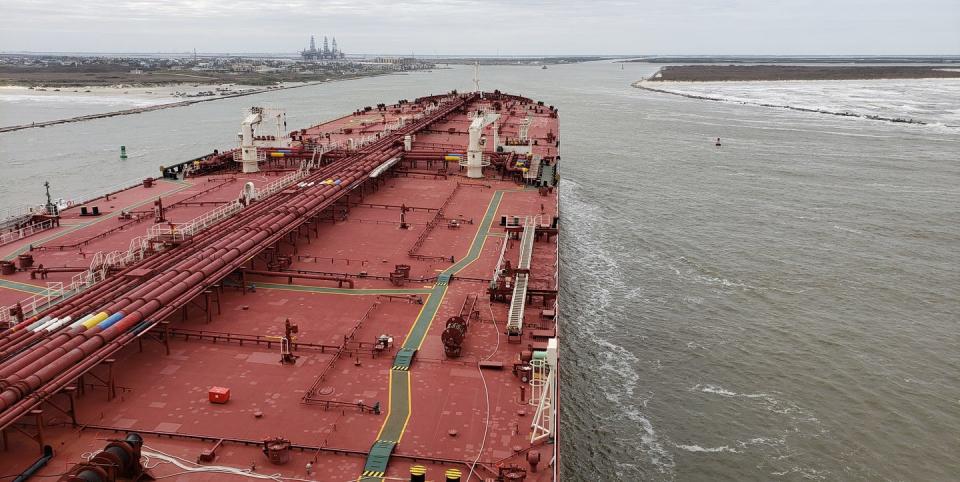
The Hong Kong Spirit is a behemoth, one of the largest cargo ships in the world, and the view from her bridge suggests she’s gliding serenely across the water at the mouth of Aransas Pass. But a delicate maneuver lies just ahead. All 333 meters of this vessel- nearly 1,100 feet of cargo ship-must make a dogleg turn to stay within the confines of this narrow shipping channel.
This massive Very Large Crude Carrier (VLCC) has never been to into port at Ingleside, Texas, before. In fact, it hasn’t been docked anywhere on the planet in eight months. Fortunately, four professional local pilots have rendezvoused with the Spirit, clambered up a shaky 75-foot rope ladder, and installed themselves on the bridge to help steer the ship through the narrow passage. “No one in the world goes out and brings in tankers like this,” says Trip Webb, a pilot #13 in the Aransas Pilot’s Association. “Nowhere.”
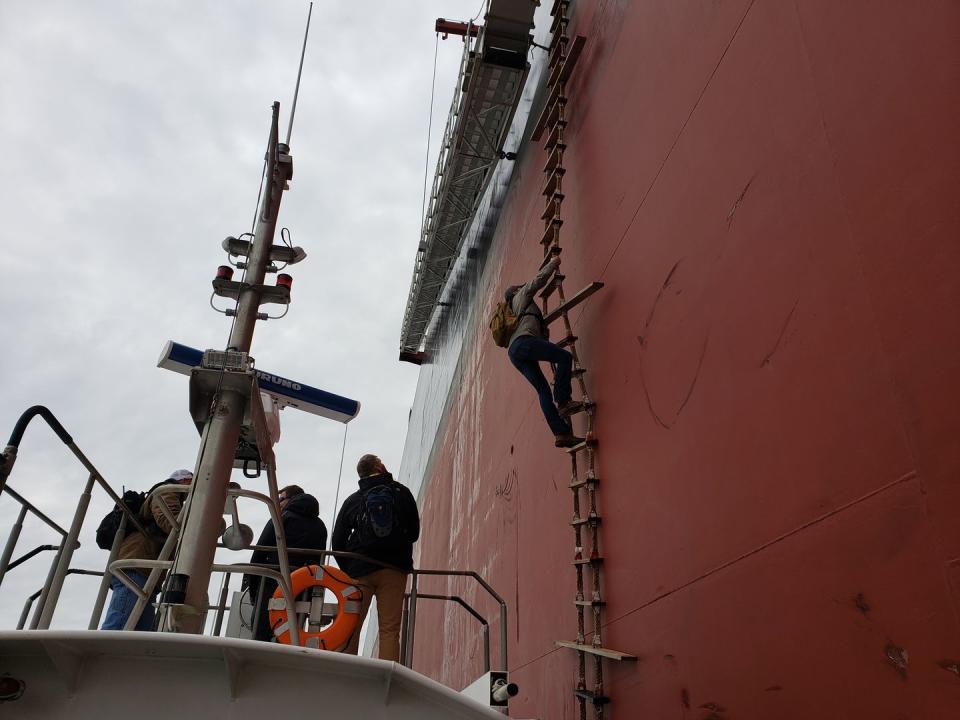
Webb cries, “Captain, make sea speed.” Maximum power from the engine will help the ship fight the current. “Yes, pilot!” the Chinese captain responds, and relays the command to the bridge crew.
Once the tanker clears the turn, the pilot orders the ship to half speed as she navigates the Corpus Christi Shipping Channel. Even so, the ship displaces so much water that a swell rolls along the channel’s side. Local surfers sometimes come out to ride this curl for more than a mile. Other residents have complained about the surges, and the port is spending nearly $100,000 on a study on ways to mitigate them. But there are no “tanker surfers” or bystanders on this cold and blustery February day. Only the wind and current battered the massive vessel, making life harder for her crew.
One pilot takes watch on the bow, another on the flying wing of the bridge. The enormous ship’s “shadow” can swallow an entire tugboat, so Webb appreciates the extra eyes and familiar voices on the radio. A small flotilla of four tugboats escorts the VLCC, and Webb coordinates their maneuvers as well, relying on the Chinese deck crew to connect and disconnect the lines, following commands routed through the captain.
The federal Energy Information Administration (EIA) now projects the United States to become a net-energy exporter by 2020, and that prediction is based in large part on what’s happening here in the Corpus Christi area. The port is already the number one exporter of crude oil in the United States, and the south Texas coast is on the leading edge of the new, booming liquid natural gas export market. Visits by huge ships like the Hong Kong Spirit are signs of this new economic reality.
A Boom on the Beach

The Spirit is just the sixth VLCC ever to navigate through the Corpus Christi Ship Channel. The ship is coming in empty and will load up on crude oil to bring to the global market. In all, it will carry more than two million barrels of oil, worth more than $120 million, away from Texas. But the ship can’t fill up all the way. When the VLCC is about three-quarters full, she’ll head to sea and meet up with a smaller tanker for a top off. Corpus Christi’s channel simply isn’t deep enough to accommodate the weight of a fully loaded VLCC.
The Port of Corpus Christi is fixing that. The public entity just received the final permit to start a $327 million project to deepen the ship channel to 54 feet deep and widen it to 530 feet, which would make it roomy enough for two VLCCs to pass each other. In mid-December, the port awarded nearly $12 million to erect a crude oil storage tank yard and pumping terminal at a more convenient place, Harbor Island, where VLCCs like the Hong Kong Spirit will be able to fill to the brim. And deep dredging is planned.
These massive infrastructure undertakings are just two among dozens of colossal infrastructure projects along Texas’ coastal bend. This crescent of sleepy beach towns and oyster-shell-crusted beaches is fast becoming a focal point for the world’s energy market. Tens of billions of dollars’ worth of public and private energy investments are transforming the area around Corpus Christi at a blinding pace. And most of them are dedicated to exporting energy-something that wasn’t possible until just a few years ago.
In 2015, the federal government lifted a decades-old ban on the export of U.S. oil. That ruling was a starting gun for the new energy race in South Texas. “That repeal came about three years faster than we thought, and we hadn't quite geared up for that,” says Sean Strawbridge, CEO of the Port of Corpus Christi. “I think we're playing a little bit of a catchup.”
The signs are everywhere. Sprawling liquid natural gas plants are rising. Liquified natural gas (LNG) tankers appear on the horizon. Big bridges are being raised even higher to fit large ships through the channel. So many oil tanks are being built that there is discussion of when South Texas crude storage will be a benchmark for global prices, similar to the way the tank farms at Cushing, Oklahoma, affect domestic energy prices.
The economic revolution is not lost on the Aransas pilots. “I’ve been a pilot for five years, and there are so many new docks,” Webb says. “So much has happened.”
The changes are just beginning. “All these projects are banking on all the energy resources that we have that we have, now and in the future,” says Jim Lee, an economics professor at Texas A&M University-Corpus Christi and director of the school’s South Texas Economic Development Center. “We are just starting the race to develop the infrastructure.”
Natural Gas City

Rain falls cold and steady around the natural-gas processing plant, turning the roads to mud but giving the metal towers a glistening sheen. Here at Cheniere’s Corpus Christi Liquefaction plant, the first built-from-scratch LNG export facility in the United States in nearly 50 years, weather is no object. There’s too much at stake to slow down.
Cheniere is investing $15 billion to build three freestanding gas processors, massive distilleries that can clean and convert natural gas from Texas oilfields into liquids that can be shipped across the world for resale. Rival projects in Maryland, Louisiana, and Georgia are already under way. Even though this is a construction project that will span a half-dozen years, a daily urgency underlies the operation as the race to claim market share simmers.
Ari Aziz, a Chenierie vice president and the facility’s general manager, stands inside a central control room. Around 300 people are working here at any time, not including support contractors, with half that number at the plant during weekend night shifts. “Once we start we never shut down, except for maintenance,” Aziz says.

It’s easy to lose the big picture amid the winding pipelines, hulking storage tanks, and sprawling networks of metallic girders. But in the control room, it all comes into focus. Wide windows afford a view of the entire operation. What Aziz and company cannot see they monitor with sensors and live video. A nearby white panel is decorated with green lights that indicate normal operations. It also has several serious-looking wide red buttons that can shut down the plant within moments if there’s a spill or fire.
Last year witnessed mind-bending gains in gas production in the United States, which jumped 12 percent in 2018 to a record 89.6 billion cubic feet a day, according to the U.S. Energy Information Administration. Meanwhile, domestic consumption reached 81.7 billion cubic feet per day. What to do with the excess seems clear: sell it to whomever wants to buy it. That would have been an impossibility just a few years ago, but Congress in 2015 changed a Nixon-era regulation that prevented exports of natural gas. Moving LNG around the world was suddenly possible.

This action may have changed the game, but American energy companies still had a problem. “This technology didn’t exist here” because of the ban, Aziz says. “So the skill sets really only existed outside the United States.” Aziz grew up in Trinidad and, like many of his employees, has relocated to South Texas to set up this facility after a lifetime of chasing LNG projects around the world.
Chenereire was among the first to dive in, shamelessly starting a campaign to poach the most experienced LNG operators in the world and bring them to the coastal bend of Texas. Now the office is stocked with a mix of employees from Nigeria, Iraq, Australia, Qatar, India, and Malaysia.
Oil’s Hidden Equations
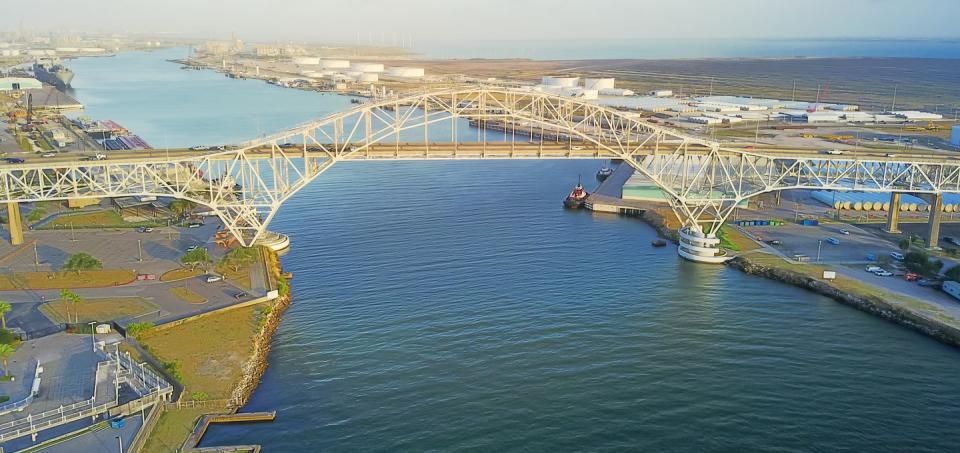
The Hong Kong Spirit is trying to parallel park, and it’s struggling. At the docks at Ingleside, a cold front has changed the wind direction from its usual northerly direction, making this already unfamiliar procedure even trickier.
Pilot Kevin Monaco takes the lead in guiding the ship’s docking from his position on the flying bridge while Webb works on the bridge and another pilot takes watch on the bow. Monaco has to bend over at the waist just to speak and to hear the radio over the wind. The Chinese captain stands with him and dispatches an officer to fetch a thick blue jacket to ward off the cold. “She’s not making it easy,” Monaco says of the hulking ship. From the deck, things appear to be smooth. But under the surface there is a titanic struggle between the swift moving current in the channel and the ships’ engines. The only surface sign of the power involved in this clash is the column of white, churning water behind the VLCC and each of the four heaving tugboats.
The ship can go forward and reverse, but needs the tugs to make lateral movements. One such ship is pulling the tanker toward the dock. Pointing and speaking loudly, Monaco tells the captain to have his deck crew release the lines. A half-dozen figures in one-piece work suits and hard hats appear on deck, working the ropes. The freed tug slides easily past the narrowing gap between the aft of the ship and the pier.
“In the 21st century,” the captain says in earnest, broken English, “teamwork is the most important thing.”
The U.S. is setting records-and shattering moods-in the boardrooms of OPEC nations. For the first time since 1973, when figures began to be tallied, the United States exported more barrels in a single week (9211,000 barrels per day for the week of November 30) than it imported. The EIA says these sales will continue as crude production increases and U.S. domestic consumption decreases. Mega-tankers like the Spirit are harbingers of this historic comeback. But they are useless without pipelines to bring the crude to the coast for shipment.
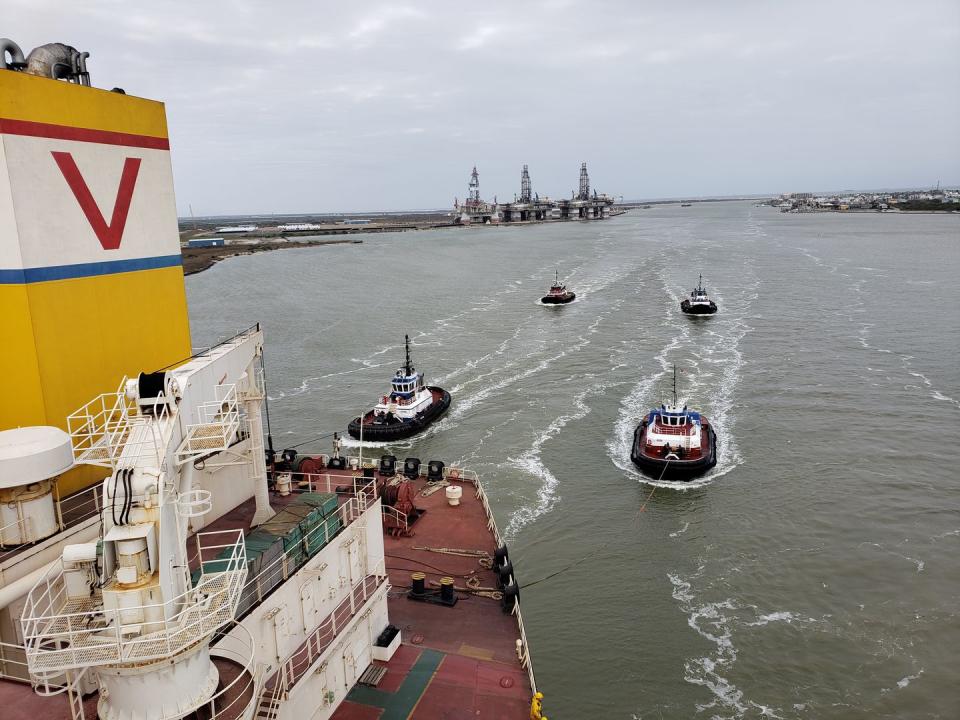
“You have energy production that's frustrated in the fields right now,” Strawbridge says. “There's not enough takeaway capacity-takeaway being pipelines.”
That’s changing. Pipelines are starting to come online this year and a rush of crude is heading toward the Gulf Coast for export. Along those racing to put pipelines and piers in place to move American crude oil, there is a competition among cities vying for the big ship traffic that will carry it away.
“We have the good fortune of being located nearest, or the nearest people at a port, to two of the largest energy-producing fields in the country, the Eagle Ford shale, and the Permian and Delaware basins,” says Strawbridge. Even with those advantages, Corpus Christi must fend off rivals-and Strawbridge wouldn’t be a good port operator if he didn’t get a dig in on his competition. “We also had the good fortune of being very close to deep water, unlike Houston,” he says. “Houston is not a coastal city. They brought the coast to Houston by digging out a 50-mile-long ditch.” The Houston Ship Channel is 45 feet deep, and Corpus is going to dredge to 54 feet with the help of the U.S. Corps of Engineers, who in early 2019 was awarded the first contract. “We're through all the bureaucratic hurdles,” he says.
And Strawbridge isn’t competing against other cities only. A new competitor making a bid for VLCC traffic is offshore export facilities that would bypass ports entirely. Such offshore sites could store crude on shore and then pump it 15 miles offshore, where the deep water allows large ships to fill up.
Environmentalists decry the method as overly risky, and regulatory permitting for these projects is a bruising process. And yet, last August Enterprise Products Partners announced plans to build such a massive offshore oil-exporting terminal south of Galveston. Soon after, a commodities firm called the Trafigura Group sought permits to build its “Texas Gulf Terminals Project” 12.7 miles off the coast of North Padre Island, right in Corpus Christi’s backyard. The company says the deepwater terminal will have flow rates of up to 60,000 barrels per hour and the capacity to load eight VLCCs per month.
Maybe 12.7 miles doesn’t sound like much. But such advantages get amplified by the economies of scale that make the entire oil trade profitable. The truth is that, without scaling up the facilities along the American coastlines, the nation cannot compete as a major exporter. “There's always a demand for [crude] if the economics are right, if the price is right,” Lee says. “We can't export anything if the price is not high enough to cover the shipping cost.”
Such economics explain why VLCCs are so big. If it currently costs about $40 to produce a barrel of oil, down from about $80 two decades ago, and the barrel sells for $50. The difference will hardly cover the cost of shipping American crude all the way to Asia or Europe. Using bigger ships means selling each barrel at a lower price, and in this game every dollar counts.
The transformation of South Texas is a staggering lesson in economy of scale. It’s not greed alone driving this; it’s fear. The economics won’t work unless the Coastal Bend goes big. Everything that is happening is predicated on the oil fields staying productive and the new, permitted pipelines opening as expected. “A field of dreams strategy is not one that we employ,” Strawbridge says. “We know the pipelines are coming with a high degree of certainty, so we're going to deploy that capital. There's no reason for us to build more docks if there's no more volume coming our way. We're expecting 2.7 to five million more barrels a day of incremental volume coming to Corpus Christi, That's what we're building towards”
“The shipping costs are still too high for us to send oil right now, as much as we can, overseas,” Lee says. “We're not at that point yet.”
LNG Rising
“Cheniere didn't tell anybody about that 500-foot candle they put up,” Strawbridge says.
He’s talking about a flare stack, the long chimneys tipped with flickering flames of burning gas that have become the signature visual of oil refineries. Cheniere’s LNG plant uses flare stacks, but they are only during maintenance. “If you see a flare at an LNG plant, it’s wasting money,” Aziz says.
The flare stack is the kind of eyesore that raises the ire of locals. (Chenerie spends about $1 million per year in community outreach.) “Texas’ community is more sensitive. This is not Louisiana,” Aziz says. “They are tough here, but fair.”
Strawbridge and others with the port now find themselves as the buffer between that community and the developers like Cheniere trying to build a new energy coast. On the one hand, newly worded lease agreements give the Port more leverage over tenants, and more abilities to intercede on behalf of concerned citizens. On the other, the land the Port owns is zoned industrial, so there are few legal steps to stop any construction.
And with no obstacles, Cheniere could charge forward. One of its huge processing units is already finished and producing 750 million cubic feet of sellable natural gas per day, and the place is a sight to behold. Natural gas comes in through a single pipeline before compressors drive it through a Rube Goldberg network of towering pipes, which cleans particulates and sulfides out of the gas. Then gravity and other gases combine forces to convert the natural gas to a liquid form that’s dense enough to ship in bulk.
The liquid product waits for export in massive, double-walled tanks that are tall enough to need lights to ward off airplanes. One such tank is already finished-an apartment-building-size concrete structure that looks like it could withstand an airstrike. The facility is closely guarded and is built to withstand a category 5 hurricane. Another tank sits half-finished next to it, showing the second wall (mandated by law) and the first fixtures of its hardened roof (not mandated but a good idea).
Now the gas just needs a place to go. There’s a massive ship docked at the facility’s port, loading up on LNG. The 297.9-meter-long LNG Schneeweisschen ("Snow White") is flagged out of Panama but sails under a 20-year charter by Uniper Global Commodities to ship LNG from Texas to, well, wherever it will sell. It’s one of a growing global fleet of new LNG haulers, efficient craft that can bring savings from new efficient engines. One of Snow White’s tricks-using a natural gas powered engine for slow speed operations.
It takes about five days to fill the tanker with 180,000 m3 of LNG. The tanks fill simultaneously and evenly, so that if the ship has to leave during an emergency, the sloshing liquid inside won’t throw her off balance.
Within days after leaving Texas, the Schneeweisschen is plying the waters of the Caribbean. Twenty-four days later, she arrives into a port just north of Surat, India.
Docking the Future
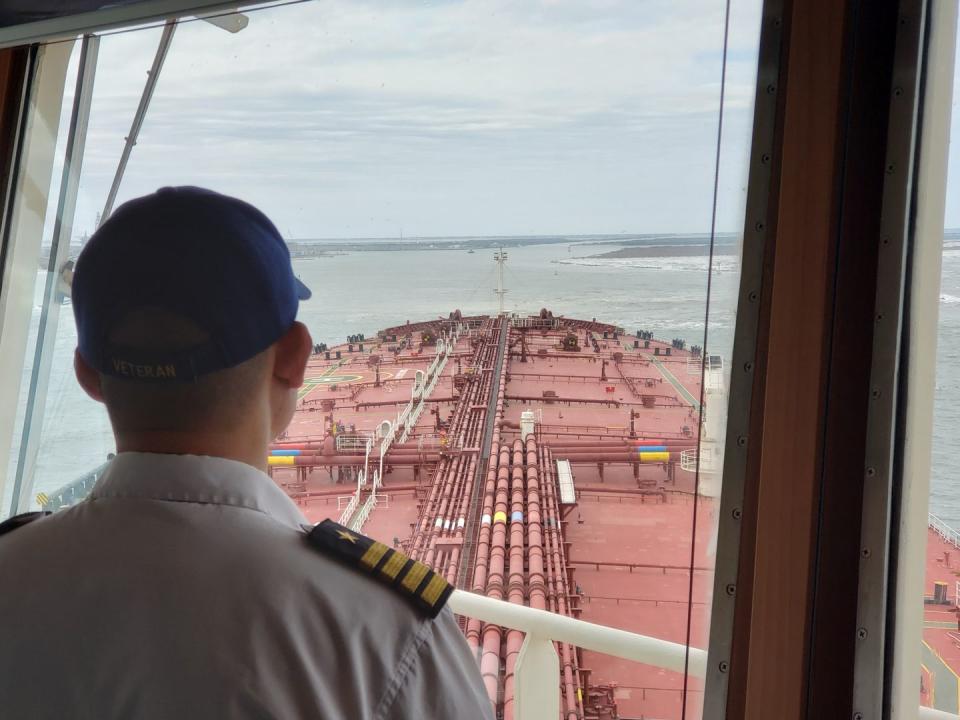
The Spirit of Hong Kong is finally wedged into the pier as crews line up the manifolds that connect to the pier’s oil pumps. After thousands of sea miles and a delicate run through the narrow channel, the VLCC’s voyage is now measured in mere feet.
The pilots’ jobs are done. For now. Every super-tanker that comes in means another chance for Aransas–Corpus Christi pilots to get familiar with these massive ships. “We’re still getting our feet wet,” Monaco says. “All the owners want to move as fast as possible, so it’s important that there’s a third party like us keeping an eye out. For us, the most important thing is safety.”
The Chinese captain offers the pilots dinner as they wait for the ship’s crew to secure the ship to the dock, and they eat a decent spread of prawns, eggs, Canadian bacon, pork ribs, and green tea. In over an hour, they disembark on the first gangway connected to the ship. This crew has already done one (albeit smaller) job today and is eager to go home. There will be plenty more ships coming.

For the pilots, the global drama that is unfolding in their waterways is taken one vessel at a time. “Things have flip-flopped,” Webb says. “Now we bring 'em in light and they leave loaded with Texas crude. And I think that’s pretty cool.”
('You Might Also Like',)
